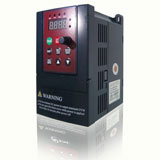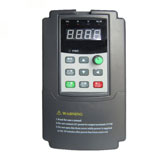Frequency inverter energy efficiency calculation
The prime and immediately tangible target for saving energy using frequency inverters is old mechanical systems, typically using centrifugal pumps and fans, that vary the flow of either water or air in a building or industrial facility. To identify, frequency inverter manufacturers are making it as easy as possible to calculate possible savings, providing PC and even iTunes applications in addition to the know-how for doing the quick hand calculations on-the-spot to quantify potential energy savings.
"Our energy-saving software and programs are geared toward the building engineer and owner. The engineering community is very well informed as far as what applications to attack to save energy," says Joe Twohill, "but software applications are geared toward the end user to make them more knowledgeable about how to save energy within their facilities."
He says the ability to do quick calculations is a great tool for the engineer because he can do a walk through with the building manager or engineer, and show them an application. "If we replace a bypass valve with a frequency inverter, the savings calculators quantify the benefits of moving to energy-efficient frequency inverters," he says. "Engineers have the option to run the calculations by hand, although the software is a very quick, easy way to do it and also provides a printout."
A cross-section of targeted frequency inverter applications include exhaust fans, supply fans, return-type fans, chilled and water circulating pumps and areas where you can eliminate dampers or valves from the mechanical system using a fan or pump to control speed, flow, pressure or temperature. Some of these areas are often overlooked for improving energy efficiency and creating more effective building controls and plant facilities management. Frequency inverters also can save energy when used on cooling towers, and users can easily model a cooling tower like a fan.
The one-page calculator gives the engineer a tool to do the calculations on-the-spot versus going to a website and downloading a tool. Users select the frequency inverter type of application, input frequency inverter parameters for the flow and an operational curve, then add the power and demand rates to calculate a quick energy-savings estimate.
The manual calculations assume a load profile of 70 percent for pumping and 60 percent for fan applications. One advantage of using the iTunes calculator is that users can provide the load profile itself. That allows the building manager or engineer who understands the flow of the system to easily calculate a very accurate, energy savings and payback.
The ability to enter the operational profile can also help with designing process fans or pumps that engineers may be implementing in a machine or within their facility. If there are specific requirements for a specific CFM or pressure, and the frequency inverter application uses a centrifugal pump (not a positive displacement pump) or a centrifugal fan (not a vane axial fan), the calculators work very well.
Rebates are a final area for engineers to explore since many local, county and state agencies, as well as the power utility companies themselves, are providing rebates to users that install frequency inverters on fans and pumps. Programs are different for manufacturing facilities and office buildings but rebates can be as much as $100 per horsepower, though the general range is $50-75 depending on the area. Rebates and labor charges for installation are calculated into the payback when using the iTunes or PC calculation tools.
"Our energy-saving software and programs are geared toward the building engineer and owner. The engineering community is very well informed as far as what applications to attack to save energy," says Joe Twohill, "but software applications are geared toward the end user to make them more knowledgeable about how to save energy within their facilities."
He says the ability to do quick calculations is a great tool for the engineer because he can do a walk through with the building manager or engineer, and show them an application. "If we replace a bypass valve with a frequency inverter, the savings calculators quantify the benefits of moving to energy-efficient frequency inverters," he says. "Engineers have the option to run the calculations by hand, although the software is a very quick, easy way to do it and also provides a printout."
A cross-section of targeted frequency inverter applications include exhaust fans, supply fans, return-type fans, chilled and water circulating pumps and areas where you can eliminate dampers or valves from the mechanical system using a fan or pump to control speed, flow, pressure or temperature. Some of these areas are often overlooked for improving energy efficiency and creating more effective building controls and plant facilities management. Frequency inverters also can save energy when used on cooling towers, and users can easily model a cooling tower like a fan.
The one-page calculator gives the engineer a tool to do the calculations on-the-spot versus going to a website and downloading a tool. Users select the frequency inverter type of application, input frequency inverter parameters for the flow and an operational curve, then add the power and demand rates to calculate a quick energy-savings estimate.
The manual calculations assume a load profile of 70 percent for pumping and 60 percent for fan applications. One advantage of using the iTunes calculator is that users can provide the load profile itself. That allows the building manager or engineer who understands the flow of the system to easily calculate a very accurate, energy savings and payback.
The ability to enter the operational profile can also help with designing process fans or pumps that engineers may be implementing in a machine or within their facility. If there are specific requirements for a specific CFM or pressure, and the frequency inverter application uses a centrifugal pump (not a positive displacement pump) or a centrifugal fan (not a vane axial fan), the calculators work very well.
Rebates are a final area for engineers to explore since many local, county and state agencies, as well as the power utility companies themselves, are providing rebates to users that install frequency inverters on fans and pumps. Programs are different for manufacturing facilities and office buildings but rebates can be as much as $100 per horsepower, though the general range is $50-75 depending on the area. Rebates and labor charges for installation are calculated into the payback when using the iTunes or PC calculation tools.

 High quality frequency inverters for electric motor speed controls in energy-saving solutions.
High quality frequency inverters for electric motor speed controls in energy-saving solutions.

